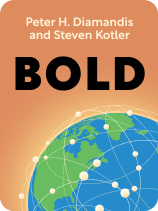

This article is an excerpt from the Shortform book guide to "Bold" by Peter H. Diamandis and Steven Kotler. Shortform has the world's best summaries and analyses of books you should be reading.
Like this article? Sign up for a free trial here.
What is Peter Diamandis and Steven Kotler’s book Bold about? What are the main takeaways of the book?
Despite having promising ideas, most up-and-coming entrepreneurs struggle to bring their innovations to fruition and make a large-scale impact. In Bold, Peter Diamandis and Steven Kotler explain that this struggle is even more intense due to today’s technological revolution.
Read below for a brief overview of the Bold book by Diamandis and Kotler.
Bold: How to Go Big, Create Wealth and Impact the World
Over the past few decades, technology has fundamentally altered our way of life. According to Peter Diamandis and Steven Kotler’s book Bold, it’s also changed the nature of business and the steps up-and-coming entrepreneurs must take to succeed. Technology has caused products and industries to develop at an exponential rate, making old ways of innovating and competing obsolete. If entrepreneurs fail to adapt to this new rate of change, their success will either be short-lived or nonexistent. To achieve and maintain success—the ability to change the world in some way—in the technological age, Diamandis and Kotler argue that entrepreneurs must adjust their mindset and strategies so they’re always ahead of the exponential curve.
Diamandis is a physician, engineer, and entrepreneur. He’s founded over 20 companies, including The XPRIZE Foundation, Singularity University, Celularity, and Bold Capital Partners.
Kotler is an author, journalist, and entrepreneur. He’s published numerous best sellers, including the nonfiction book The Art of Impossible and the sci-fi thriller The Devil’s Dictionary. Both works explore the maximum potential of human minds and bodies. Kotler is also well-known as the founder of Flow Research Collective, a peak performance research and training organization.
Diamandis and Kotler are also the best-selling authors of Abundance, which discusses how humanity can harness the power of exponentially growing technologies to support the basic needs of everyone on Earth.
Step #1: Become an Exponential Innovator
To achieve and maintain success in the digital era, the authors argue that entrepreneurs must become exponential innovators—this means adopting a ceaseless commitment to creating daring and novel ideas, products, or services that change the world in some way. (The authors refer to this as having a “bold mindset.”)
Becoming an exponential innovator is important because, in the age of the internet, innovations are never safe from competition. Once an idea or product is made available online, it develops at an exponential rate because anyone anywhere can instantaneously access and share it. This means that someone will inevitably use your idea to create something better. The only way to avoid this inevitability is to ceaselessly innovate and outperform yourself before someone else does—to become an exponential innovator.
There are two main components that make exponential innovators successful and that you must adopt to become one—psychological strengths and innovators’ habits. Psychological strengths are the mental abilities that give you the confidence and motivation necessary to pursue daring ideas. Innovators’ habits are the strategies and techniques you rely on to develop daring ideas and bring them to fruition.
Step #2: Build Credibility With a Closed Network
Once you’ve adopted the psychological skills and innovators’ habits necessary to become an exponential innovator, you must create a support network. Your support network will help advance your innovation from the infant stage—a good idea—into a large-scale success: a publicly-endorsed innovation that has changed the world in some way.
The authors’ ideas on networking are divided into two themes. First, create a closed network of people that you have personal relationships with. These people will help you build credibility by offering the critical feedback, connections, and resources necessary for you to accomplish your micro-goals. The people in your closed network are specifically chosen by you.
After creating a closed network and accomplishing your micro-goals, create an open network of people who may not know you personally but support—often financially—your innovation. These people will help you achieve large-scale success. Unlike your closed network, any member of the public can choose to join your open network.
Step #3: Reach Large-Scale Success With an Open Network of Investors
The third step in creating a successful innovation, and the second part of building a support network, is to create an open network of members of the public who’ll provide you with the finances and popularity necessary for your innovation to succeed.
Why do you need an open network to succeed? Diamandis and Kotler elaborate that the final step to releasing your innovation with high credibility is to capture public attention through excellent advertising and press coverage. This will allow your innovation to reach as many people as possible and achieve true success—the ability to change the world in some way. However, the necessary publicity requires more funds than your closed network members can provide—hence the necessity of open network members who’ll invest in your cause.

———End of Preview———
Like what you just read? Read the rest of the world's best book summary and analysis of Peter H. Diamandis and Steven Kotler's "Bold" at Shortform.
Here's what you'll find in our full Bold summary:
- How to become a successful entrepreneur and maintain your success
- The three steps to becoming an innovator
- The psychological strengths needed to handle the high-stress commitment to innovation






